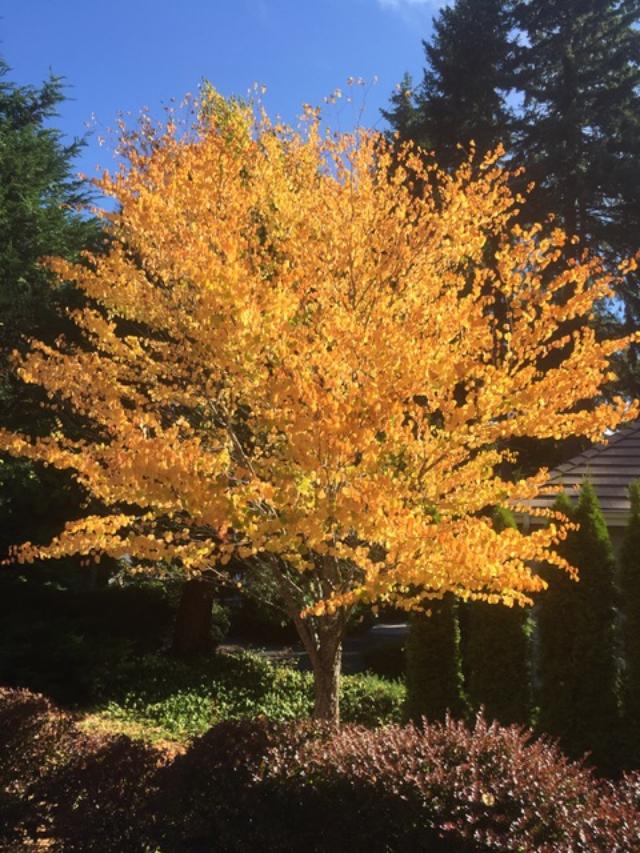by Barbara Faurot
It would be difficult to overstate the benefits of trees to our homes and communities. Aesthetic beauty, shade, wildlife habitat, wind protection, slope retention, and privacy screening are just the beginning. Trees filter the air we breathe by removing dust and other particulates. Leaves absorb carbon dioxide and transform it into biomass through photosynthesis, and give off oxygen. In fact, a single mature hardwood tree will sequester about 50 pounds of carbon per year — the amount emitted by the average American car.
Port Townsend, named a Tree City USA for nearly 20 years by the Arbor Day Foundation, is home to some notable trees. Examples range from the graceful gnarled branches of the locust tree near the Bell Tower in Uptown Port Townsend to the huge old red oak across from the courthouse on Jefferson Street. Planted generations ago, they have absorbed countless tons of carbon — and we continue to enjoy their beauty, shade, and inspiration today.
The City of Port Townsend recognizes trees of special significance through a landmark tree program. A landmark tree can be on a street, in a park, or on private property (with the permission of the owner). Because of the tree’s contribution to the environment and city character, it may be protected throughout its useful life. More information about the program, including how to nominate a tree, can be found at https://www.codepublishing.com/WA/PortTownsend/html/PortTownsend12/PortTownsend1224.html.
For the home gardener, planting a tree now helps continue the cycle. Sarah Fairbank, long-time Master Gardener and self-described “plant nerd,” cites an apt quote by Ralph Waldo Emerson: “The creation of a thousand forests is in an acorn.” A tree planted today will benefit life in many forms, including mammals, birds, other plants, fungi and invertebrates.
Sarah adds that fall is the best time to plant trees. Cooler temperatures and fall rains help establish roots in the still-warm soil, setting them up for strong growth next spring.
If you are choosing a tree to plant this fall, “right plant, right place” is the key. Consider the plant’s hardiness and space needs, as well as its preferences for sunlight, water, soil type, and drainage. WSU Extension’s Home Garden Series FS047E “Planting Trees and Shrubs in the Landscape” offers details on planting practices and potential problems. https://pubs.extension.wsu.edu/planting-trees-and-shrubs-in-the-landscape-home-garden-series
In late summer and early fall, existing trees respond to shorter days by beginning to store up reserves for the winter. As their food-making process slows, chlorophyll breaks down, and the red, orange, and yellow pigments become visible. Where the leaf stem is attached to the tree, a layer of cells forms and severs the tissues that support the leaf. The tree “seals” the cut, leaving behind a protective scar when the leaf falls. You can work fallen leaves into the soil, add them to compost, or leave them in place as mulch. They’ll help suppress weeds, conserve soil moisture, and build organic matter.
For questions about trees, including fall tree planting and care, you can contact Sarah, who volunteers at the Master Gardener Plant Clinic, at ptmgplantclinic@gmail.com.
For inspiration throughout the season, Karen I. Shragg, author and retired naturalist at the Wood Lake Nature Center in Minnesota, has generously offered permission to share her poem.
Think Like a Tree
By Karen I. Shragg
Soak up the sun
Affirm life’s magic
Be graceful in the wind
Stand tall after a storm
Feel refreshed after it rains
Grow strong without notice
Be prepared for each season
Provide shelter to strangers
Hang tough through a cold spell
Emerge renewed at the first signs of spring
Stay deeply rooted while reaching for the sky
Be still long enough to hear your own leaves rustling.
(Barbara Faurot is a Jefferson County Master Gardener and Master Pruner, working with other volunteers who serve as community educators in gardening and environmental stewardship.)
Published in the Port Townsend Leader September 9, 2020


